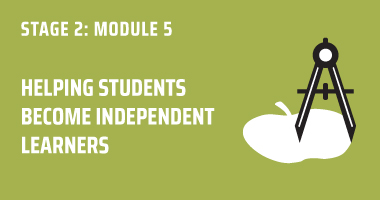Lesson 3 - Instructional Moves to Get Students to Chew Productively
HELPING STUDENTS BECOME INDEPENDENT LEARNERS
TIMING/TASKS: Video Length 20 minutes. To complete this lesson: 1) Watch video to end; 2) Read additional text below; 3) Download & complete exercise(s) in right column
TIMING/TASKS: Video Length 15 minutes. To complete this lesson: 1) Watch video to end; 2) Read additional text below; 3) Download & complete exercise(s) in right column
Instructional Moves to Get Students to Chew Productively
OUTCOMES
LESSONS IN THIS MODULE
DOWNLOADS / EXERCISES
RESOURCES
EXERCISE
I will understand and be able to articulate how these instructional moves begin to upend inequity by design, without a specific mention or focus on race or cultural responsiveness.
I will recognize that my role as a cognitive mediator is to coach the most vulnerable learners in my classroom to sharpen their elaboration (chewing) skills as the path to improving their competence as learners.
I will practice using the “pit tools” to help facilitate instructional conversations with my dependent and compliant learners so that they can level up their learning.
Our last lesson (Lesson 2) focused on getting students to reframe how they approach errors, in anticipation of getting them into the learning pit where there will be confusion, grappling, and mistakes as they take on more complex learning. This reframe is essential to getting students to engage in productive struggle that grows brain power.
Now that you’ve established the error as information reframe, you and students will have a common language for navigating social-emotional dimensions of cognition. Next, we want to look at your role in helping students chew productively.
The goal of “chewing” during the elaboration, in the information processing cycle, is to turn inert content – new facts and figures in the curriculum — into usable knowledge. It is important to note that chewing is much more than “engagement.” Just because students are active and participating doesn’t mean that learning is happening.
We want to help students resist superficial, surface learning, where new content is never really understood, simply regurgitated for tests, and promptly forgotten. Getting students to chew productively so that this doesn’t happen is tied to your role as a cognitive mediator. Or, as we say in Ready for Rigor parlance, your role as the “personal trainer” of students’ cognitive development.
This concept is mentioned throughout Module 2 and Module 3 in Stage 1. As a cognitive mediator, you are the facilitator of meaning-making, not the meaning giver. When we over-scaffold we are the meaning giver. But before we can reduce our overgrown scaffolds, that act as cognitive crutches for dependent learners, we have to help them become more productive chewers of the content — to get to meaning-making.
So, in this lesson, we look at the specific instructional moves a cognitive mediator uses to build student capacity.
There are three (3) meta-moves that are foundational in your practice as the personal trainer of student learning:
- Direct the brain’s attention to the right part of the learning process
- Coach to provide a bit of stretch to increase students’ cognitive stamina within their zone of proximal development
- Engage in “micro-sized” instructional conversations during elaboration (chewing) to help students practice being meta-strategic and/or figuring out complexities in the moment
Through these instructional meta-moves, dependent learners build their capacity to carry more of the cognitive load over time. This expands their ability to process information more effective so that new knowledge gets integrated into their background knowledge, moving them toward cognitive independence.
Take note — these aren’t some esoteric CRT moves. You will recognize them. What is different is that we are being intentional in focusing them on helping the most vulnerable students work through a set of internal cognitive moves.
Remember, under-developing the cognitive capacity of Black, Brown, and Indigenous students is the primary way inequity by design maintains itself. Therefore, culturally responsive instruction has to improve student cognition for Black, Brown, and Indigenous students who are stuck being dependent learners.
The biggest misconception is that we are simply teaching “critical thinking skills” and all we need to do is ask better questions. The research into the science of learning tells us otherwise.
Improving information processing is NOT synonymous with critical thinking. It is the foundation upon which critical thinking becomes possible. So, be sure to check your language as you talk about this part of the work. Too often we are quick to reduce new practices or new applications of established practices to something we feel we already know. Consequently, we’ll miss the power of the practice.
The Personal Trainer’s Toolkit
There’s a concept around coaching students called the “third space.” Research tells us that our ability to coach another to higher levels of performance is easier when we couple our instructional conversation with an artifact of some kind, in this third space.
We will delve into the “third space” more in a later lesson, the important piece I want to offer right now are tools, for you to use with students, that create an artifact to anchor your conversation. I call them “learning pit” tools or “pit tools” for short.
These pit tools help make thinking visible and your instructional conversation actionable so that students move toward understanding. This is really important when working with dependent learners at all grade levels, across all disciplines.
ACTION ITEMS
Pay attention to the quality of chewing currently (assess current reality)
Select one of the meta-moves to focus on with your dependent learners for 2 weeks or so to get a feel for the move. Note student reactions.
Rotate in another meta-move and go through the same process.
Save to My Content

